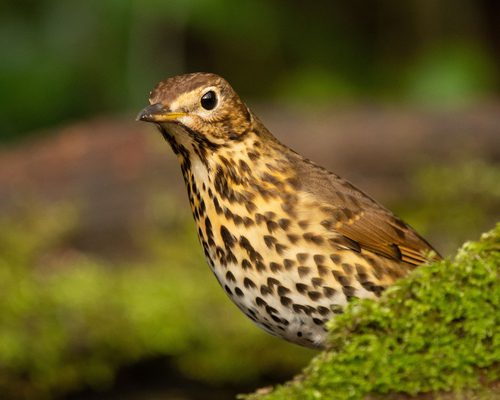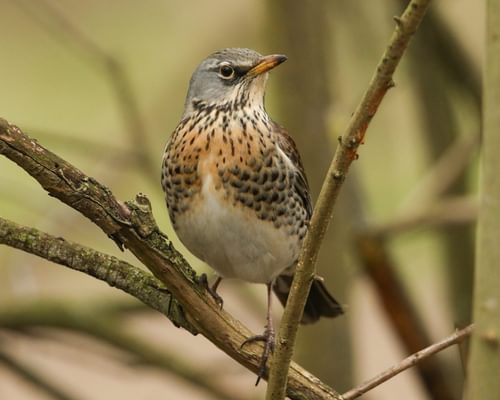Mistle Thrush
Least ConcernTurdus viscivorus
Visual Identification
Appearance
The Mistle Thrush is a large, stocky thrush with greyish-brown upperparts and a white underside marked with bold, dark spots. Its head features a slight greyish tinge, and its long tail has white corners visible in flight. Legs are yellowish-brown, and the bill is dark grey-brown.
Both sexes look similar, with juveniles showing a more spotted appearance on their upperparts. The bird's plumage remains consistent throughout the year, with no significant seasonal changes.
The underside of the wings is white, which is a key way of identifying the species from the Song Thrush, which has buffish-orange underwings.
Size
Length
26cm to 29cm
Wingspan
45cm to 50cm
Weight
93g to 167g
Colours
Males and females have similar plumage
Primary Colour
Brown Grey
Secondary Colour
White Buff
Beak Colour
Brown
Leg Colour
Brown Yellow
Habitat and Distribution
Habitats
Woodland
Garden
Wetland
Coastal
Urban
Farmland
Grassland
Desert
Tundra
Rainforest
Mountain
Savanna
Distribution
Mistle Thrushes inhabit many wooded habitats across Europe and parts of Asia. They prefer open woodlands, parklands, and large gardens with scattered trees. These birds are also found in orchards and hedgerows.
In the UK, they are resident year-round, while northern and eastern populations may migrate south for winter. They are widespread across Britain and Ireland, adapting well to human-modified landscapes.
Elevation Range
Up to 600 meters
Climate zones
Temperate, Subarctic
Distribution Map
This map gives you a rough idea of where you might spot a Mistle Thrush. The coloured areas show countries where these birds have been seen.
A few things to keep in mind:
- Birds might not be everywhere in the coloured areas, for example, they may be present around the coast of that country
- Where birds live can change with seasons and available food
- This map is quite simple - it doesn't show exact locations
We're working on making our maps even better! Soon, we hope to show you:
- More detailed maps for bigger countries, including state and region
- How birds move around during different seasons
Distribution by Region
Behaviour and Ecology
Bird Attributes
This feature is in beta. We'd love your feedback to improve it!
Share your thoughtsBird Attributes Explained
Our bird attributes system rates various aspects of a bird's capabilities on a scale of 0-100, based on data from field observations, scientific studies, and expert knowledge.
Attribute Categories:
- Agility: Manoeuvrability, speed, and grace in flight or movement.
- Strength: Physical power, often correlating with size and hunting abilities.
- Adaptability: Ability to thrive in various environments or changing conditions.
- Aggressiveness: Territorial behaviour and assertiveness, particularly during breeding seasons.
- Endurance: Stamina, often seen in migration patterns or foraging behaviours.
Understanding the Ratings:
- 0-20: Very Low
- 21-40: Low
- 41-60: Average
- 61-80: High
- 81-100: Very High
Remember, these attributes are relative to other bird species and don't necessarily indicate superiority.
Hover over the icon next to each attribute for more information.
Tap the icon next to each attribute for more information.
Agility
Reflects the bird's manoeuvrability, speed, and grace in flight or movement.
The Mistle Thrush demonstrates considerable agility, particularly in its ground foraging behaviour. Its ability to run and pause in an alert upright stance suggests quick reflexes and manoeuvrability. Their capacity to perch on high branches and navigate through various wooded habitats also indicates good agility.
Strength
Indicates the bird's physical power, often correlating with size and hunting abilities.
As a large, robust thrush, the Mistle Thrush possesses above-average strength for its size. This is evident in its ability to defend fruit-bearing trees against other birds and its capacity to build sturdy nests high up in trees. However, it's not exceptionally strong compared to larger bird species.
Adaptability
Represents the bird's ability to thrive in various environments or changing conditions.
Mistle Thrushes show high adaptability, thriving in various habitats from open woodlands to urban parks and gardens. Their ability to switch diets seasonally, nesting in diverse locations, and adapting to human-modified landscapes demonstrates their flexible nature. Their presence across a wide elevation range further supports this adaptability.
Aggressiveness
Measures the bird's territorial behaviour and assertiveness, particularly during breeding seasons.
Mistle Thrushes are renowned for their bold and aggressive behaviour, particularly in defending food sources and nesting areas. Their fierce protection of fruit-bearing trees and willingness to confront potential predators indicate a high level of aggression. This trait is a key aspect of their survival strategy.
Endurance
Reflects the bird's stamina, often seen in migration patterns or foraging behaviours.
The Mistle Thrush exhibits good endurance, as evidenced by its ability to sing from treetops even during stormy weather (earning it the nickname "Stormcock"). Their partial migratory behaviour in some populations also suggests decent endurance. However, they are not known for exceptionally long-distance flights or extreme feats of stamina.
Diet
Mistle Thrushes primarily feed on invertebrates, including worms, snails, spiders, insects and their larvae. They also consume various fruits, particularly berries and mistletoe berries, which they fiercely defend. In winter, they may switch to a more fruit-based diet when invertebrates are scarce.
Behaviour
Mistle Thrushes are known for their bold and aggressive behaviour. They fiercely defend fruit-bearing trees and bushes against other birds. They often perch conspicuously on high branches, especially during their breeding season.
These birds typically forage on the ground, running and pausing in an alert, upright stance.
Vocalisation
The Mistle Thrush has a distinctive, far-carrying song consisting of short, repeated phrases with brief pauses. It's often described as a loud, fluty warble, "chur-chur-trrrrrr-chur-chur."
Their alarm call is a harsh, rattling "chack-chack-chack," giving rise to their nickname "Stormcock" for singing during rough weather.
Nesting & Breeding
Mistle Thrushes begin their breeding season in early spring, with males establishing territories through song. Pairs often form long-term bonds. They typically nest in the fork of a tree or on a branch, sometimes quite high up (up to 30ft).
The nest is a sturdy cup made of twigs, grass, and moss, lined with finer materials. Females lay 3-5 pale blue or greenish eggs with reddish-brown spots. Both parents share incubation duties.
Incubation lasts about 12-15 days, carried out solely by the female, with chicks fledging after another 14-16 days. Mistle Thrushes often raise two broods per season, fiercely defending their nesting area from potential predators.
Lifespan
years
The Mistle Thrush typically lives for 3 to 5 years.
Like all birds, lifespan can be affected by factors including predation, habitat quality, disease, and access to food sources.
Conservation and Status
Global Conservation Status
While listed as Least Concern globally, Mistle Thrush populations have declined in some areas, particularly in the UK. Habitat loss and changes in agricultural practices are potential threats. Conservation efforts focus on maintaining suitable woodland and parkland habitats.
Birdwatching Tips
- Look for Mistle Thrushes in open woodlands, parks, and large gardens
- Listen for their distinctive rattling call, often given from treetops
- Observe their aggressive behaviour when defending food sources
- In the UK, watch for them singing from high perches, even in stormy weather
Additional Information
Quick Facts
Other names:
Stormcock
Family:
TurdidaePredators
Main predators of Mistle Thrushes include Sparrowhawks, cats, and corvids such as Magpies and Jays, which may prey on eggs and nestlings.
Did You Know?
- Mistle Thrushes get their name from their fondness for mistletoe berries.
- They are known as "Stormcocks" for their habit of singing from treetops during stormy weather.
- Other names include 'Jeremy Joy' because it sings early in the year (thought to be a play on the phrase ‘January joy’) and ‘Big Mavis’, an old English dialect word for a thrush.
- Mistle Thrushes are one of the earliest nesting birds in Europe, sometimes starting as early as February.
Was this bird profile helpful?
Your feedback helps us improve our content
Thanks for your feedback!
Your input helps us improve our content.
Community Experience
Community Ratings
No ratings yet - be the first to rate this bird!
Latest Community Reviews
No reviews yet
Sign in to be the first to review
Community Reviews
Create Your Free Account Welcome Back!
Join our community to rate birds and share your experiences. Creating an account is completely free and only takes a minute. Sign in to your account to rate birds and share your experiences with our community.
Your information is secure and will never be shared.
By creating an account, you agree to our Privacy Policy.
Similar Birds
References
- 1 2
website: BirdLife International. 2016. Turdus viscivorus. The IUCN Red List of Threatened Species 2016: e.T22708829A87878799.
View source - 3
report, 2015: EBCC

